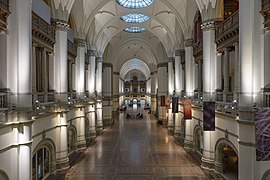Nordic Museum
- Machine translation, like DeepL or Google Translate, is a useful starting point for translations, but translators must revise errors as necessary and confirm that the translation is accurate, rather than simply copy-pasting machine-translated text into the English Wikipedia.
- Do not translate text that appears unreliable or low-quality. If possible, verify the text with references provided in the foreign-language article.
- You must provide copyright attribution in the edit summary accompanying your translation by providing an interlanguage link to the source of your translation. A model attribution edit summary is
Content in this edit is translated from the existing Swedish Wikipedia article at [[:sv:Nordiska museet]]; see its history for attribution. - You may also add the template
{{Translated|sv|Nordiska museet}}to the talk page. - For more guidance, see Wikipedia:Translation.

Bus: 44.
Tram: Djurgården Line
Ferry: Djurgården ferry


The Nordic Museum (Swedish: Nordiska museet) is a museum located on Djurgården, an island in central Stockholm, Sweden, dedicated to the cultural history and ethnography of Sweden from the early modern period (in Swedish history, it is said to begin in 1520) to the contemporary period. The museum was founded in the late 19th century by Artur Hazelius, who also founded the open-air museum Skansen. It was, for a long time, part of the museum, until the institutions were made independent of each other in 1963.
History
The museum was originally (1873) called the Scandinavian Ethnographic Collection (Skandinavisk-etnografiska samlingen), from 1880 the Nordic Museum (Nordiska Museum, now Nordiska museet). When Hazelius established the open-air museum Skansen in 1891, it was the second such museum in the world.
For the museum, Hazelius bought or got donations of objects like furniture, clothes and toys from all over Sweden and the other Nordic countries; he emphasised the peasant culture, but his successors increasingly started to collect objects reflecting bourgeois and urban lifestyles as well. For Skansen, he collected entire buildings and farms.
Although the project did not initially get the government funding he had hoped, Hazelius received widespread support and donations and by 1898, the Society for the promotion of the Nordic Museum (Samfundet för Nordiska Museets främjande) had 4,525 members. The Riksdag allocated some money for the museums in 1891 and doubled the amount in 1900, the year before Hazelius died.
Building

The present building, the design of Isak Gustaf Clason, was completed in 1907 after a 19-year construction process. Originally, it was intended to be a national monument housing the material inheritance of the nation. It was, however, only half-completed for the Stockholm Exposition 1897, and it never was completed to the extent originally planned, three times the actual size. It takes its style from Dutch-influenced Danish Renaissance architecture (i.e. buildings such as Frederiksborg Palace) rather than any specifically Swedish historical models. The core of the "cathedralesque" building is taken up by a huge main hall (126 meters long) passing through all the stories up to the roof and dominated by the enormous sculpture of King Gustav Vasa, the Swedish so called founder-king. For the construction, brick and granite was used for the walls, while concrete was used for the roof.[2]
Collections
The museum has over 1.5 million objects in its collections, including buildings such as the Julita farm in Södermanland, Svindersvik in Nacka, Tyresö Palace in Tyresö, and the chaplain farm at Härkeberga near Enköping. The museum archive also houses an extensive collection of documents and approximately 6 million photographs dating from the 1840s until today.[3][4] The museum research library contains 3,800 shelf meters of literature from the 16th century and onward.[5]
Gallery
Exterior
-
 Sculpture on the western gable
Sculpture on the western gable -
 Spire
Spire -
 Onion dome
Onion dome -
 Gilt scuppers
Gilt scuppers -
 Street View
Street View -
 From south
From south
Interior
-
 Entrance hall with Gustav Vasa
Entrance hall with Gustav Vasa -
 Main hall
Main hall -
 Roof lantern
Roof lantern -
 Exhibition on the history of dining table arrangements
Exhibition on the history of dining table arrangements
See also
References
- ^ "Besöksrekord på landets museer" (PDF). Riksförbundet Sveriges museer. Retrieved 22 November 2016.
- ^ Johansson, Bengt O H (1999). "Norra innerstaden". Guide till Stockholms arkitektur (2nd ed.). Stockholm: Arkitektur Förlag AB. p. 42. ISBN 91-86050-41-9.
- ^ "Collections". Nordiska museet. Retrieved 11 October 2014.
- ^ "Fotografiska samlingar". Nordiska museet. Retrieved 2016-11-22.
- ^ "Bibliotekets samlingar". Nordiska museet. Retrieved 2016-11-22.
External links
- Official website
- Nordic Museum within Google Arts & Culture
 Media related to Nordiska museet at Wikimedia Commons
Media related to Nordiska museet at Wikimedia Commons
- v
- t
- e
- ABBA: The Museum
- Artipelag
- Biologiska museet
- Dansmuseet
- Lightship Finngrundet (1903)
- Fotografiska
- Hallwyl Museum
- Hamn (museum)
- Jewish Museum of Sweden
- Junibacken
- Konstnärshuset
- Långholmen Prison
- Liljevalchs konsthall
- Livrustkammaren
- The Maritime Museum
- Medelhavsmuseet
- Millesgården
- Moderna Museet
- Museum of Ethnography
- Museum of Far Eastern Antiquities
- Museum of Medieval Stockholm
- Nationalmuseum
- Nobel Prize Museum
- Nordic Museum
- Stockholm Observatory
- SS Orion
- Royal Coin Cabinet
- Skansen
- Spårvägsmuseet
- Museum of Spirits
- Stockholm City Museum
- Stockholm County Museum
- Stockholm Music Museum
- Stockholm Palace
- Strindberg Museum
- Sven-Harry's Art Museum
- Swedish Army Museum
- Swedish Centre for Architecture and Design
- Swedish History Museum
- Swedish Museum of Natural History
- Swedish Museum of Performing Arts
- Swedish National Museum of Science and Technology
- Thiel Gallery
- Toy Museum Stockholm
- Vasa Museum
- Villa Lusthusporten
- Waldemarsudde























